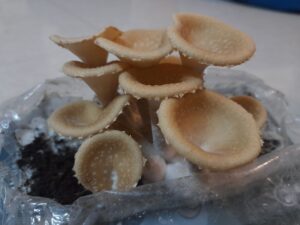King Tuber Oyster Mushroom: 3 Diseases it can protect you from: (PART 1/3)
Pleurotus tuber regium. The King Tuber Oyster Mushroom. This warm-weather mushroom has long been revered for its medicinal properties in parts of Western Africa, China and North East India. As the only sclerotium-forming member of the Pleurotus genus, it is unique in its ability to store nutrients for a rainy day. Here is a 3 part series taking a look at 3 diseases that this wonderful mushroom can protect you from.


In Part 1, we will refrain from fixating on the evolutionary wonders of the sclerotia but instead, look to them as sources of medicinal compounds. In particular, we will investigate some existing evidence relating the sclerotial extracts to antitumor or anticancer properties.
Part 1: Cancer
Beta-glucans as active molecules
Our journey begins at the Chinese University of Hong Kong where Peter Cheung and colleagues made use of hot alkaline water to extract polysaccharides from the sclerotia of P. tuber-regium. Polysaccharides are long chains of sugar molecules such as glucose that are connected to each other through chemical bonds. These polysaccharides are important structural components of every fungal cell. In their study, the researchers chose to focus primarily on the long and branched polysaccharide molecules known as beta-glucans.

The researchers used two commonly used cancer cell lines to test the effects of their beta-glucan extracts. HL-60 cells are derived from a patient suffering from acute myeloid leukemia (AML), a form of blood and bone marrow cancer that is also the most common form of such cancer in adults. When they treated the cells with their beta-glucan extracts, they noticed that the outer membranes of the cells became more porous. A blue dye called Trypan blue which is normally kept out of the cancer cells by the cell membrane was able to enter the cells and stain them blue. This indicated that the extracts were able to disrupt the integrity of the cell membrane of the leukemia cells.

To verify whether the extracts could work on other forms of cancer, the researchers used another cancer cell line called HepG2 cells. HepG2 cells are derived from hepatocellular carcinoma (a form of liver cancer) and are commonly used to screen drugs for toxicity and study liver cancer. When these cells were treated with the P. tuber regium beta glucan extracts their metabolic activity decreased. A decrease in metabolic activity indicates stressed, dying, or non-functional cells. This indicated that the P. tuber regium beta-glucan extracts had a negative effect on the HepG2 cells as well.

At this point, an obvious question that the researchers had to answer was whether the adverse effects seen by the extracts were only on cancer cells. The extracts could have similarly deleterious effects on normal and healthy cells too, which would make them hazardous for consumption. To check if this was true, they tested the extracts on kidney cells obtained from an African green monkey (Vero cells) and found that the effects that they had observed on the cancer cells could not be seen here. This was an indication that the extracts were more harmful to cancer cells than to normal cells.
The importance of solubility
Now that they had some evidence that the beta-glucan extracts from P. tuber regium had some anti-cancer effects, the scientists wanted to improve the solubility of the extracts to make them more easily consumed. To do this, they modified the beta-glucan molecules by adding water-loving or hydrophilic chemical groups to them through a process known as carboxymethylation. This made the molecules easily soluble in water and therefore more bioavailable. They then added different doses of this modified beta-glucans to a human breast cancer cell line (MCF 7 cells). They observed a dose-dependent decrease in the metabolic activity of these cells. By monitoring the change in the number of DNA molecules in the treated and untreated cells they showed that the treated cells were multiplying much slower than the untreated ones. Further investigation showed that the treated cells were more prone to death as well. This highlighted the anti-cancer abilities of these extracts against breast cancer cells.
Size matters
The evidence provided by the studies so far sheds some light on the ability of P tuber regium sclerotial extracts to prevent or reduce the growth of cancer cells. However, a cell in a dish in the lab does not replicate the dynamic environment within the body. Another group of scientists from China’s Wuhan University decided to dissect this very aspect. They chose to work with Sarcoma 180 cells, a highly malignant mouse cancer cell line widely used in the field of cancer biology. They extracted water-soluble compounds from the sclerotia of P. tuber regium and further separated the molecules based on their sizes and biochemical properties. Once again the beta-glucans proved to be the molecules of interest. Moreover, the size of the beta-glucans had an impact on their effectiveness. Longer beta-glucan chains were more active when compared to the shorter ones. When it came to beta-glucans and their anti-cancer activities, size did matter it seemed.
In vivo effects
To replicate a more likely pre-clinical scenario, the Sarcoma 180 cells were transplanted under the skin of mice and allowed to form an active tumour. These mice were then injected with either 5-fluorouracil (an anticancer drug) or the beta-glucan extracts from P. tuber regium every day for eight days. On the ninth day, the tumours were dissected and weighed. Two of the extracts tested outperformed 5-fluorouracil and showed a greater reduction in tumour weight. This indicated that the extracts were not only able to prevent cancer cell growth in a dish, but also do so when injected into live animals.
Taking a look at the evidence so far points to the ability of the polysaccharide extracts from Pleurotus tuber regium to inhibit the growth of cancer or tumor cells. However, it is important to keep in mind that all of these studies have been performed under highly controlled laboratory settings using well-established, immortal cell lines and do not necessarily recapitulate the true behavior of the disease. The in vivo mouse study by Zhang et. al. does indicate that the injected molecules are able to find the tumor and affect its growth negatively. However, the mode of injection, the location of the tumor, and the dosing protocol did not perfectly reflect an actual clinical scenario in a human patient. No successful clinical trials have been conducted to date that conclusively shows the efficacy of such extracts in the treatment of cancers or tumors. Keeping this in mind, we must evaluate the evidence that continues to grow day by day. Can these mushrooms help in the treatment of cancer?
Only time can tell. But they sure are delicious!
References
Cheung, Peter C. 2001. “Chemical structure and chain conformation of the water-insoluble glucan isolated from Pleurotus tuber-regium.” Biopolymers.
Zhang, L. 2001. “Evaluation of mushroom dietary fiber (nonstarch polysaccharides) from sclerotia of Pleurotus tuber-regium (Fries) singer as a potential antitumor agent.” J Agric Food Chem.
Zhang, Lina. 2008. “Characterization of polysaccharide-protein complexes by size-exclusion chromatography combined with three detectors.” Carbohydrates Research.
Zhang, Lina. 2009. “Chemical modification and antitumor activities of two polysaccharide-protein complexes from Pleurotus tuber-regium.” Int J Bio Macromol.
Zhang, Mei. 2003. “Molecular mass and chain conformation of carboxymethylated derivatives of beta-glucan from sclerotia of Pleurotus tuber-regium.” Biopolymers.
Zhang, Mei. 2004. “Carboxymethylated β-glucans from mushroom sclerotium of Pleurotus tuber-regium as novel water-soluble anti-tumor agent.” Carbohydrate Polymers.

 Neeladri Chowdhury
Neeladri Chowdhury


